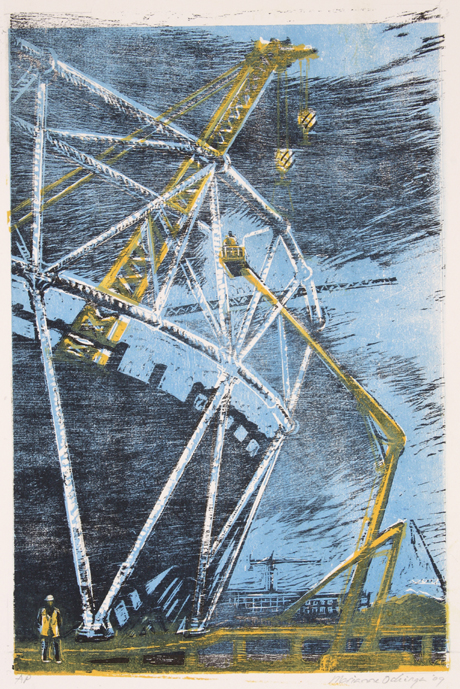The making of an Olympic moment

One of Marianne Fox Ockinga's woodcuts of the Olympic stadium
There are several different kinds of fence that run along the sides of the Greenway. The fence starts out as split pine slats, too weak to lean a bicycle against; gradually it becomes a chest-high metal mesh, eventually reaching three metres into the cold foggy air, coiled barbed wire along the edge.
“I just find it less and less human here, this bit. There were lots of plants here. Lots of shrubs and things. This was supposed to be the green way.”
Marianne Fox Ockinga began observing the Olympic Park when the Greenway was still a verdant patch lined with trees and blackberry bushes. Since then she has seen the rate of change increase.
She watched as the largest crane in the country lifted the white girders to crown the brim of the stadium.
“The first one they lifted up, I was filled with emotion. I was sitting on the ground and then a little higher up, and I did some strong charcoal sketches. At the time, I thought, I cannot catch this, but somehow it’s got the excitement.”
Her woodcuts show bold contrasts of colour, sharp lines of crane and infrastructure crossing, speckled with the occasional bright beacon of a human worker.
“I really hated those hoardings with the colours on it. I had to choose some of the colours, because otherwise it would be too chaotic. I’ve got to edit it. I go for the structural forms. I like the soils and things taking shape. But I have to do something with the foreground, that’s the trouble. There are all these vehicles everywhere. I have to pick things out.
“For example, I don’t particularly like that bus. But I find that concrete mixer quite interesting. It has a good shape and it’s also immediately to do with construction.”
Marianne is the only artist who has been consistently working inside the unfinished stadium. She documents the transitory landscape of bleachers, cranes, beams, soils and cements through woodcuts.
Freezing her impressions of this industrial process into prints, she captures details of construction quickly in sketches and then cuts them into wood and prints them with a Colombian presses in her Islington studio.
Every time she visits she has to suit up in the appropriate gear. Luckily, she is familiar with the building company and the requirements of being an observer in a structurally unstable environment. Her first encounter with McAlpine was on the site of the Arsenal Stadium, after she had worked for a few years sketching, painting, and making woodcuts of on the new King’s Cross train station.
The Olympic Stadium is the most intense in security, scale, and complete occupation of the area. There are no remnants of the former area of Pudding Mill, except perhaps the station itself. All of the structures surrounding have been built since London won the Olympic bid.
The security system has grown with the building works. The site will eventually be able to accommodate up to 11,000 workers on site. At present Marianne passes through three checkpoints with photo ID cards and fingerprinting to get to her perspective on the stadium.
She attends the site twice a week in good weather. Less when a cold wind blows, as her papers tend to catch in the breeze and her fingers become stiff around the chalk and pencils.
She usually spends a couple of morning hours on the little plastic chair placed on the large, exposed, observation platform; she can sometimes be frantically sketching if there is a lot of movement going on. Later, she decides which images to develop into full woodcuts.
In order to descend from her platform beneath the stadium’s upper lip, she has to rattle the cage of the hoist. If the hoist’s operator is not on a tea-break he will send up the car to take her down. Then she goes for lunch herself, usually in the main canteen, where the portions are workman sized.
She says it must be her Dutch taste that leads her to prefer it to the “posh” canteen where there are more women from the offices and one can order a wider choice of salads. In the onsite workman’s café, she is often the only woman in the room, apart from the canteen personnel.
Workers on the site have engaged with Marianne’s work. A site supervisor came to her studio to look at her collection of finished prints of the half-finished stadium. He had worked in Stratford, on various construction sites, for the past ten years. He told Marianne, “I see it this way – dark.”
Marianne points out that her images are “both moody and happy at the same time. I always have this mix especially because it’s to do with construction. It’s always apprehensive.”
Marianne Fox Ockinga’s work on the Olympic Stadium has been exhibited in the ING Discerning Eye Exhibition at the London Mall Galleries, and was also on display in De Bloei Van De Houtsnede II (The Flowering of the Woodcut) in Amsterdam at the Galerie Petit earlier this year.
Several prints will be in the Originals 10: Contemporary Printmaking show at the Mall Galleries from 25 March – 3 April.
Fox Ockinga’s solo show, which will include sketches involved in the process of her print making, will be displayed in the Buro Happold offices in Newman Street from 2 March for approximately 6 weeks.
For information on future exhibitions, current, and past work, see Marianne Fox Ockinga‘s website.
